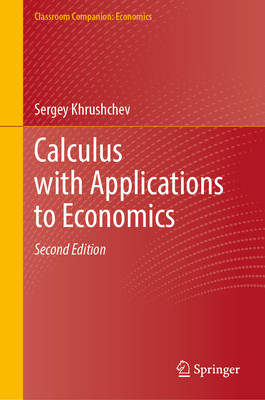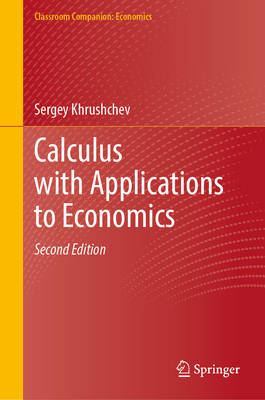
Bedankt voor het vertrouwen het afgelopen jaar! Om jou te bedanken bieden we GRATIS verzending (in België) aan op alles gedurende de hele maand januari.
- Afhalen na 1 uur in een winkel met voorraad
- In januari gratis thuislevering in België
- Ruim aanbod met 7 miljoen producten
Bedankt voor het vertrouwen het afgelopen jaar! Om jou te bedanken bieden we GRATIS verzending (in België) aan op alles gedurende de hele maand januari.
- Afhalen na 1 uur in een winkel met voorraad
- In januari gratis thuislevering in België
- Ruim aanbod met 7 miljoen producten
Zoeken
Omschrijving
This book presents classical Calculus in a novel way by integrating examples from modern Economics. Drawing inspiration from historical algebra textbooks--rich with buy‐sell problems that once prepared students for the economic challenges of their times--the book offers a modern counterpart designed for today's Calculus students, many of whom will pursue careers in business and management. Readers will discover, for example, why Descartes could not derive a formula for the tangents to logarithmic curves, why banks employ functions that describe explosive growth, and why production functions are often modeled by the Cobb-Douglas form. The book also explains the contrasting shapes of demand curves--why a product with many substitutes has a demand curve that is convex downward, whereas a monopoly's demand curve is convex upward--and shows how the elasticity of demand can be used to achieve maximum revenue, among many other intriguing insights. Mathematics enthusiasts will appreciate the captivating account of Brouncker's continued fractions and their role in approximating π to many digits as early as 1655. Meanwhile, students of Economics will benefit from a comprehensive treatment of Optimization Theory, covering topics from single-variable problems to the application of Lagrange's multipliers and utility theory. By interweaving historical insights with practical applications, this book not only reinforces fundamental concepts of Calculus but also demonstrates their relevance in solving modern economic problems. Each chapter is structured to present a historical narrative that elucidates the development of key mathematical ideas, followed by modern examples that illustrate their application in Economics. This dual approach enhances the learning experience and encourages both critical thinking and creative problem-solving. Ultimately, the book serves as a bridge between the theoretical elegance of classical mathematics and the dynamic challenges of contemporary economic analysis. It is our hope that this work will inspire students and educators alike to explore the rich interplay between Mathematics and Economics, fostering a deeper appreciation for the enduring relevance of classical ideas in today's rapidly evolving academic and professional landscapes.
Specificaties
Betrokkenen
- Auteur(s):
- Uitgeverij:
Inhoud
- Aantal bladzijden:
- 469
- Taal:
- Engels
- Reeks:
Eigenschappen
- Productcode (EAN):
- 9783031953484
- Verschijningsdatum:
- 28/08/2025
- Uitvoering:
- Hardcover
- Formaat:
- Genaaid
- Afmetingen:
- 156 mm x 234 mm
- Gewicht:
- 857 g

Alleen bij Standaard Boekhandel
+ 335 punten op je klantenkaart van Standaard Boekhandel
Beoordelingen
We publiceren alleen reviews die voldoen aan de voorwaarden voor reviews. Bekijk onze voorwaarden voor reviews.









